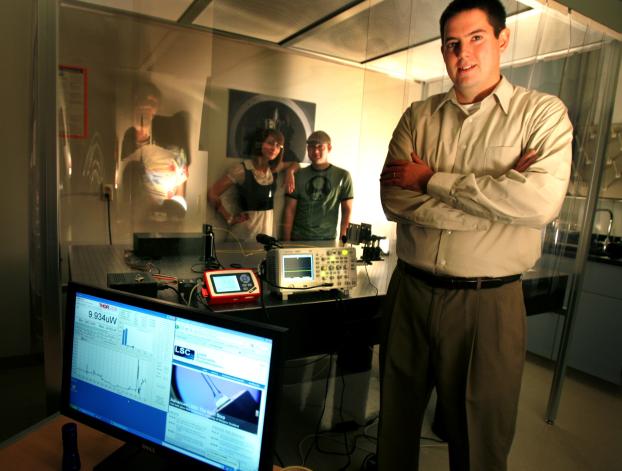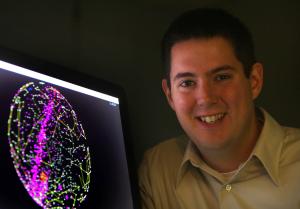 Caption: Joshua Smith stands next to the clean room devised by student researcher Chris Francis. In the background are undergraduate Cinthia Padilla and graduate student Thomas Abbott. Photo by Karen TapiaDownload Photo
Caption: Joshua Smith stands next to the clean room devised by student researcher Chris Francis. In the background are undergraduate Cinthia Padilla and graduate student Thomas Abbott. Photo by Karen TapiaDownload Photo
University Stem Initiative
Exploring the Universe
Researchers Try to Detect Ripples in Space and Time
Gravitational waves of the kind hypothesized by Albert Einstein in his General Theory of Relativity could provide the basis of a new tool to explore the universe.
As part of an entirely new spectrum, gravity waves, if they exist, might enable detection and study of black holes — which are not measurable by the electromagnetic spectrum, including visible light, infrared, radio, x-ray, ultraviolet and gamma.
And better understanding of black holes could lead to better understanding of the origin of the universe.
The problem is that gravitational waves have thus far eluded the detection efforts of scientists worldwide, including those of Joshua Smith, assistant professor of physics, and his team of student researchers.
Exploring Space and Time
Technology has advanced enough in recent years to make detection of the waves predicted by Einstein more feasible. But the task is complicated by the waves’ weakness when they reach Earth and the background noise of life on this planet, which plays havoc with the delicate instruments at the Laser Interferometer Gravitational-Wave Observatory Collaboration (LIGO) detection sites in Livingston, La., and Hanford, Wash.
Smith’s aim is to sift through noise to get the to real data. In the course of his efforts, the students who work with him are gaining valuable research experience and expertise.
Research Experience Brings Grant Funding
Smith left his position as a postdoctoral physics research associate at Syracuse University to join Cal State Fullerton in January 2010, bringing 12 years experience in gravitational wave research, including doctoral work at the Max Planck Institute for Gravitational Physics in Germany.
He has been awarded nearly $300,000 in National Science Foundation and Cottrell College Research Corporation for Scientific Advancement funding to improve detectors. He has attracted students to the new discipline, and, in the process of searching for waves, has seen two of his students advance from neophytes to full scientists. Smith’s work aligns with universitywide efforts to expand science, technology, engineering and mathematics education.
“We’ve never had gravitational wave research on this campus,” explains James M. Feagin, chair and professor of physics. “Now that Dr. Smith is here, it opens a whole new area, and it’s ‘big science,’ meaning it deals with large-scale projects on major theories and has connections with many other researchers and institutions internationally.
“Whenever a new area is opened, if you have a dynamic person and a team player like Dr. Smith involved, it means new grants will be attracted – he’s been here less than a year and he’s brought in nearly $300,000 already – and we can recruit bright students and faculty interested in the gravitational wave branch of physics, which could attract even more grants, more students, more faculty.”
As to connecting to other scientists and institutions, Feagin said, that has begun. “Jay Marx of Caltech, LIGO director, has already spoken at our campus because of Dr. Smith. Marx met with administrators and me. LIGO has international connections.”
Student Researchers
Chris Francis, a physics master’s student interested in optics and lasers, joined Smith in February 2010. He started with an empty lab that needed to be set up for the research Smith would conduct.
“He helped design it,” Smith said. “Then I acquired the equipment, and he set it up and made it work.”
Francis also designed a clean room — which keeps out as much dust, lint and particulates as possible — with a rotating table for his optics work, and computerized controls to manipulate the research remotely in order to preserve the unsullied environment.
“I was testing materials for LIGO and devising ways to minimize light scatter and reduce noise,” Francis said.
Working at the same time as Francis was senior physics major, now graduate student Thomas Abbott, who is now pursuing additional study with Smith.
“Dr. Smith’s presentation on gravitational waves impressed me; he knew so much and could answer every question, so I asked to join him,” Abbott said. “My independence evolved quickly. He was there to help, answer questions and bounce ideas, then he’d step back.”
Abbot said Smith selected him in part because of his computer expertise, “but when I found we needed to refine our analytical programming, it meant I had to teach myself a lot of UNIX computer language in a hurry."
Smith said Abbott so impressed other researchers with his analytical and computer abilities that LIGO scientists promoted his status as a co-author on LIGO research papers.
“Because researchers must overcome many different obstacles, I look for students with motivation, drive and problem-solving characteristics,” said Smith. “Those are characteristics of good researchers. Thomas and Chris had them, and in class I talk about the research challenges and how they were met.”
One of the newest team members, sophomore physics major Cinthia Padilla, is refining computerized search routines to detect astronomical movements. “It’s hard work, but I’m learning a key is persistence. Just because it doesn’t turn out how you’d like the first few times doesn’t mean everything is wrong. You just keep solving, keep going for the goal.”
“We’re like those who separate chaff from wheat,” Smith explains. “Refining and purifying will push LIGO research to the next level, improving the sensitivity of the detectors and the quality of the resulting data.”
Jan. 11, 2011
 Joshua Smith sits beside a computer displaying the program “Einstein@Home,” that can be used to search for gravitational waves. It can be downloaded via the Internet. Photo by Karen Tapia
Joshua Smith sits beside a computer displaying the program “Einstein@Home,” that can be used to search for gravitational waves. It can be downloaded via the Internet. Photo by Karen Tapia